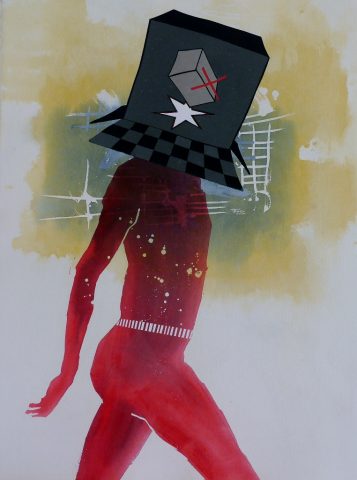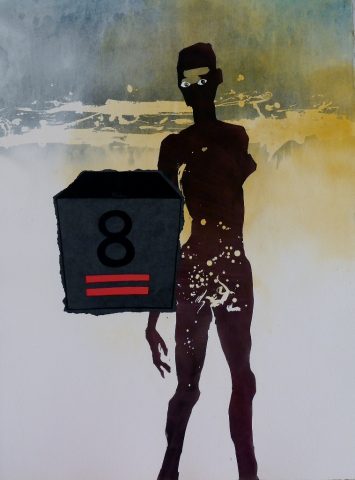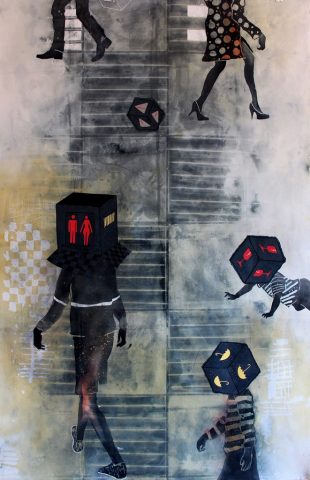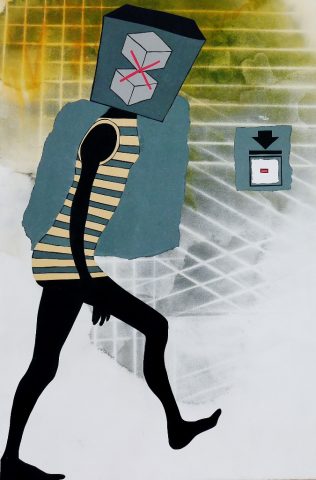David Thuku and the barter of ideas
There are only a few days left to visit David Thuku’s solo show at Red Hill Art Gallery in Nairobi, but we expect to see a lot more of him in the near future, if we will be able to follow him (out of the box).
- David Thuku, Untitled 10. Mixed Media Collage, 57 x 78 cm. Courtesy Red Hill Art Gallery.
- David Thuku, Untitled 5. Mixed Media Collage, 108 x 132 cm. Courtesy Red Hill Art Gallery.
- David Thuku, Untitled 8. Mixed Media Collage, 57 x 78 cm. Courtesy Red Hill Art Gallery.
- David Thuku, Untitled 4. Mixed Media Collage, 106 x 135 cm. Courtesy Red Hill Art Gallery.
- David Thuku, Untitled 13. Mixed Media Collage, 57 x 78 cm. Courtesy Red Hill Art Gallery.
- David Thuku, Untitled 9. Mixed Media Collage, 57 x 78 cm. Courtesy Red Hill Art Gallery.
- David Thuku, Untitled 11. Mixed Media Collage, 57 x 78 cm. Courtesy Red Hill Art Gallery.
- David Thuku, Untitled 1. Mixed Media Collage, 113 x 175 cm. Courtesy Red Hill Art Gallery.
- David Thuku, Untitled 2. Mixed Media Collage, 76 x 112 cm. Courtesy Red Hill Art Gallery.
- David Thuku, Untitled 7. Mixed Media Collage, 57 x 78 cm. Courtesy Red Hill Art Gallery.
- David Thuku, Untitled 3. Mixed Media Collage, 74 x 112 cm. Courtesy Red Hill Art Gallery.
There are artists who toot their own horn. Armed with swagger and ego, they tango with art collectors, twirling for the spotlight. Then there are those who tread lightly; artists who dive in to subterranean territory where they live quietly with their thoughts. David Thuku is from this less obtrusive camp.
Although he has been navigating the art scene in Nairobi since he graduated from Buruburu Institute of Fine Art in 2009, Thuku prefers to play with new ideas in private rather than to play the puppet in public. Gallerists and fair-masters have managed to catch up with the talented artist in recent years, exhibiting his mixed media collage at The Attic Art Space, Circle Art Gallery and The Art Space in Nairobi. Under ARTLabAfrica, he has exhibited at reputable international venues including the 1:54 Contemporary African Art Fair in London, and the Young International Artists Art Fair (YIA) and Drawing Now Art Fair in Paris.
Thuku’s exhibition Barcode: The Layer Between, currently showing at Red Hill Art Gallery in Kenya, is defined by invigorating colour, curious symbolism, geometric shape and altered figurative form. From dripping ink to silhouette photography, Nairobi galleries have exhibited an overabundance of black and white figurative art recently. This imagery has become synonymous with the word contemporary. A misuse of terminology, ‘contemporary’ is often used to describe a specific aesthetic that is consistently monochromatic and minimal, sleek and purposely ambiguous. From paper to multi-media installation, one could even argue that this brand of art is being produced deliberately for the white cube. Slap on some labels with hot-words like climate change or conservation and you have yourself an art exhibition.
The real meaning of contemporary art is simply the art of today, created in the late 20th century or in the current 21st century. Of course today’s artists live in a world in which capitalism prevails, particular resources are scarce and technology is advancing. So, while all artwork produced today is in fact contemporary, it is particularly exciting when it elicits an enquiry in to present politics and current affairs. This is why it is particularly refreshing to see that David Thuku delves deeper into issues that impact our modern day existence. In his own words about his latest series, he says he investigates, “the process of acquiring ideas and items for consuming; how we identify with things and how those things change our identity.”
Thuku explores consumption, not just focusing on consumerism but playing with the idea of acquisition in its entirety. He examines the building blocks of identity. From values, perspectives or propaganda for instance, to an item of clothing or technology, when we consume something, we digest the social construct associated with that paradigm or product, and in doing so, we are irreversibly altered. Put simply, Thuku studies how we are transformed by our choices. By replacing the heads of his figures with box signage, he attempts to show how different messages instigate change, and how people are blinded or overcome by what they choose to partake in. Most observers of his artwork ask about the meaning of Thuku’s symbolism. He says they are purposely unspecified consumables ready for the intake. “We don’t always know what they represent, but they are there to instruct.”
Thuku makes an astute remark about how the observer’s mind is also reshaped in the process of consuming his artwork. In his 12 artworks at Red Hill, his imagery consists of nude or half-dressed figures either carrying or wearing cartons over their head that advertise different iconography. All on paper, they have a digital effect closer to graphic design than painting. You rarely see a brushstroke. Thuku’s smooth, flawless images are created by soaking cold-pressed watercolour paper in water and laying them flat before applying a glaze of diluted acrylic. His patterned backdrops are made by scrubbing against the paper, which is set on top of floor tiles. “It is a kind of imprinting,” he says. He equates the geometric patterns he uses to the repetition of action or thought that ultimately becomes human behaviour. Thuku’s topmost layer consists of paper cut-outs, and despite all of the peeling and layering involved, his collages sport a seamless, unblemished effect. He compares this process of give-and -take to the construction, deconstruction and reconstruction of human ideology.
Both the stance and the attire worn by the human figure in Thuku’s untitled 5 recall the men in tomb paintings from Ancient Egypt. The short kilt evokes the wrap around shendyts of the old Kingdom from around 2130 BC. This striking artwork conjures the culture of a civilization in which consciousness was the all-important. Wealth for ancient Egyptian society was measured, not financially, but by one’s knowledge of science and spirituality. Ancient wisdom revolved around the human form and its ability to tune in to multiple levels of consciousness. It was a civilization interested in astronomy and the nature of the universe. Today’s views have woefully digressed. While Ancient Egyptian art depicted the brain as a conduit to consciousness, the brain of Thuku’s figure is replaced by a muddle of cords, most likely representative of modern day society’s hedonistic binging and precarious moral code.
For those who are behind the times, Nairobi is a thriving metropolis with a flourishing art scene, and extravagant malls where Kenyans love to shop. As Thuku comes to terms with a society marred by narcissism and malformed through commercial indoctrination and self-indulgence, he seeks his place in this new reality. “I come from somewhere else,” he says, “I’ve had to cross some borders and many things have changed my identity.” Caught in the strange transition that Kenya is undergoing, he plays the roles of witness and of experimental consumer. In constructing his persona, the philosophy he chooses to acquire and assimilate is critical. “And this is not the end of it,” he says. “It is an ongoing process, and we don’t know what comes next. All I know is that we want more than we have been confined to.”
With its magnetic yellows and reds, David Thuku’s latest series Barcode: The Layer Between is seductive, as is a conversation with the artist. The exhibition is certainly worth the trek to the green, misty hills just outside Nairobi. From a Mercedes Benz to the blueprints of thought, we become cognizant of the barcodes we stamp ourselves with. We are taught to be conscious of the repercussions of our decisions, the attitudes toward our choices, and the many layers in between. Using his artwork to dissect our belief systems, one thing becomes clear, our notion of wealth is distorted and the portal to consciousness blocked by countless futile distractions.
We can expect to see a lot more of Thuku locally and internationally. For those who want to start immediately, Barcode runs from 29th April to June 10th at Red Hill Art Gallery in Kenya.
November 25, 2020











